
The Arecaceae is a family of perennial, flowering plants in the monocot order Arecales. Their growth form can be climbers, shrubs, tree-like and stemless plants, all commonly known as palms. Those having a tree-like form are called palm trees. Currently, 181 genera with around 2,600 species are known, most of which are restricted to tropical and subtropical climates. Most palms are distinguished by their large, compound, evergreen leaves, known as fronds, arranged at the top of an unbranched stem. However, palms exhibit an enormous diversity in physical characteristics and inhabit nearly every type of habitat within their range, from rainforests to deserts.
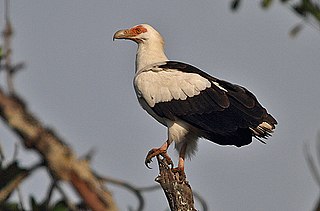
The palm-nut vulture or vulturine fish eagle, is a large bird of prey in the family Accipitridae. It is the only member of the genus Gypohierax.
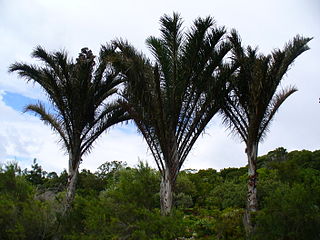
Raffia palms are a genus of about twenty species of palms native to tropical regions of Africa, and especially Madagascar, with one species also occurring in Central and South America. R. taedigera is the source of raffia fibers, which are the veins of the leaves, and this species produces a fruit called "brazilia pods", "uxi nuts" or "uxi pods".
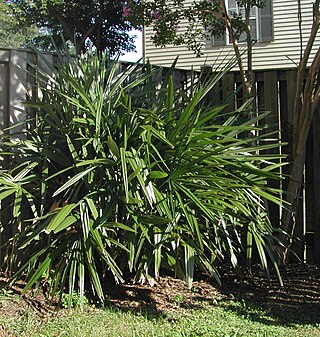
Rhapidophyllum hystrix, the needle palm, is a palm native to coastal margins of the subtropical eastern Gulf and south Atlantic states of the United States. Populations can be found from coastal southeast South Carolina, southward to Florida and west across the coastal plain of Mississippi and southern Alabama. It is one of the most cold-hardy palms in the world, and can be found growing in several areas with warm temperate climates.

Ceroxylon quindiuense, often called Quindío wax palm, is a palm native to the humid montane forests of the Andes in Colombia and Peru.
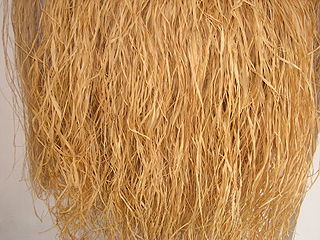
Raphia vinifera, the West African piassava palm, bamboo palm or West African bass fibre is a palm tree species in the genus Raphia. It is native to Benin, Gambia, Ghana, Nigeria, Togo, Central African Republic, Cameroon, Ghana, and Democratic Republic of the Congo. It is particularly abundant along the creeks of Niger Delta, Cross River, Lagos and Ikorodu in Nigeria.
Dypsis bejofo is a species of flowering plant in the Arecaceae family. It is a palm endemic to Madagascar. It grows on hilltops and slopes in rainforest habitat. The species is threatened by overcollection of seeds and by habitat loss. There may be only about 300 mature individuals remaining. Some grow in protected areas.

Raphia australis, the giant palm or rafia, is a species of raffia palm in the family Arecaceae. It is found around Kosi Bay in southern Mozambique and northeastern KwaZulu Natal in South Africa. It is threatened by habitat loss caused by drainage of its habitat for agriculture; it is being threatened in the Bobole Special Reserve but is more secure in the Kosi Bay area.
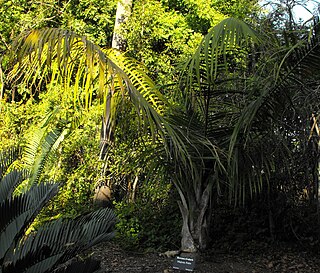
Ravenea rivularis, the majestic palm, or majesty palm, is a species of tree in the family Arecaceae. They generally grow to 10 to 12 feet tall and are often marketed in stores as a "houseplant" in a pot, in its natural state, the majesty palm may sometimes grow to 98 feet tall.
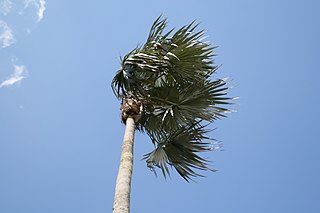
Coccothrinax proctorii, the Cayman thatch palm or Proctor's silver palm, is a palm which is endemic to the Cayman Islands.

Sabal mauritiiformis is a species of palm which is ranges from Mexico, Central America, Colombia, Venezuela and Trinidad.

Chelyocarpus ulei is a species of palm tree that is native to the western Amazon.

Calamoideae is a subfamily of flowering plant in the palm family found throughout Central America, South America, Africa, India, China, Southeast Asia and Australia. It is represented by 21 genera - containing nearly a quarter of all species in the palm family - including the largest genus, Calamus, the type genus of the group. Only four are found in the New World while the rest are Old World denizens, usually found in equatorial swampland or along tropical coastlines.

Attalea phalerata is a species of palm tree known by the English common name urucuri palm, the Portuguese common name urucurizeiro, and the Spanish common name shapaja. Other common names include motacu and bacuri. It is native to Brazil, Bolivia, Paraguay, and Peru, where it grows along southern and western Amazonia. It is the most common palm tree on the Pantanal.

Sabal miamiensis, the Miami palmetto, is a rare plant species endemic to Dade County, Florida, in the vicinity of the city of Miami.

Raphia farinifera is a tropical African palm tree occurring in lowland riparian and swamp forest, also around human habitations and cultivated locations, on stream banks and other moist situations at altitudes of 50–1000 m. Found in Angola, Benin, Burkina, Cameroon, Gambia, Ghana, Guinea, Ivory Coast, Kenya, Madagascar, Malawi, Mauritius, Mozambique, Nigeria, Réunion, Senegal, Seychelles, Sierra Leone, Tanzania, Togo, Uganda, Zambia and Zimbabwe, and naturalised in east lowlands of Madagascar. Its generic epithet is derived from raphis = 'needle', probably in reference to the 4 mm long yellowish spines on the margins and main veins of the leaflets. The specific name refers to a type of starchy flour obtained from the trunk pith – farina = 'starch', fera = 'bearing'.
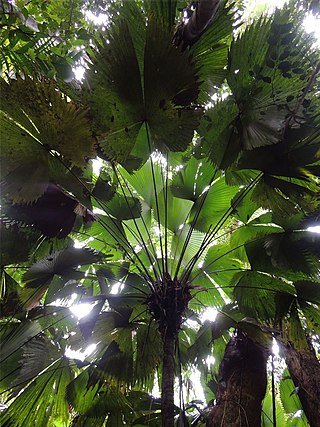
Sabinaria magnifica is a species of palm tree and the only member of the genus Sabinaria. Native to the Darién Gap on the border between Colombia and Panama, it grows from 1 to 6 metres tall with large, deeply-divided leaf blades. It has been described as "striking", "spectacular" and "beautiful" by taxonomists.

Raphia sudanica is a palm species in the family Arecaceae. It is found in Western Africa, where it is locally used for construction purposes.
Raphia hookeri is a palm species in the family Arecaceae or Palmae. It is found in Western and Central Africa, where it is locally used to make palm wine. It is best noted for its very long leaflets which in the subspecies R. h. gigantea, of Ghana and Ivory Coast, can be 11 ft 6 in in length, while only two inches wide. These are the longest leaflets known from any plant.
Lepidocaryeae is a tribe of plants in the family Arecaceae. Subtribes and genera in the tribe are:
















